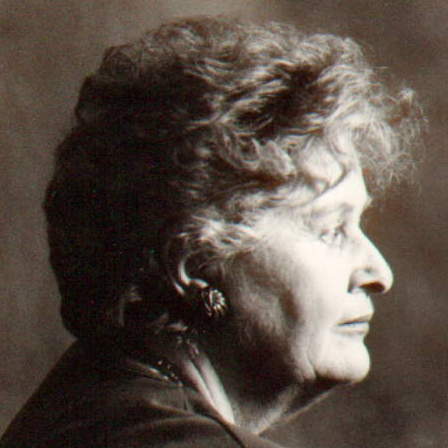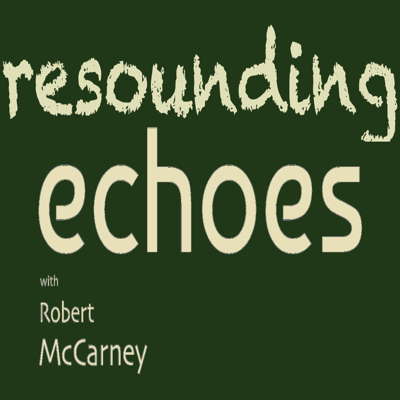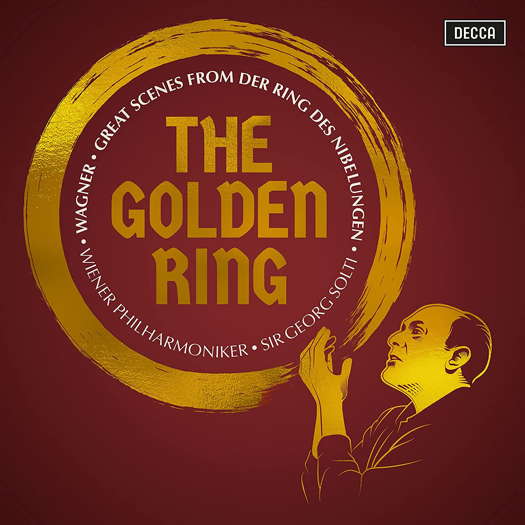 SPONSORED: An Integral Part - Lindsey Wallis looks forward to the Canadian Music Centre's tribute concert to composer Roberta Stephen.
SPONSORED: An Integral Part - Lindsey Wallis looks forward to the Canadian Music Centre's tribute concert to composer Roberta Stephen.
All sponsored features >>
 RESOUNDING ECHOES: Beginning in 2022, Robert McCarney's occasional series features little-known twentieth century classical composers.
RESOUNDING ECHOES: Beginning in 2022, Robert McCarney's occasional series features little-known twentieth century classical composers.
 VIDEO PODCAST: Slava Ukraini! - recorded on the day Europe woke up to the news that Vladimir Putin's Russian forces had invaded Ukraine. Also features Caitríona O'Leary and Eric Fraad discussing their new film Island of Saints, and pays tribute to Joseph Horovitz, Malcolm Troup and Maria Nockin.
VIDEO PODCAST: Slava Ukraini! - recorded on the day Europe woke up to the news that Vladimir Putin's Russian forces had invaded Ukraine. Also features Caitríona O'Leary and Eric Fraad discussing their new film Island of Saints, and pays tribute to Joseph Horovitz, Malcolm Troup and Maria Nockin.

A Phenomenal Reaction
GERALD FENECH admires Solti's Decca Ring Project
'John Culshaw died on 27 April 1980 ... but his spirit lives on in this perfect marriage of art and technology.'
Der Ring des Nibelungen, or as it is commonly known, 'The Ring Cycle', by Richard Wagner (1813-1883), certainly needs no introduction. Even those who abhor the work are aware of it, and what it represents. Those lucky enough to admire it never tire of going back to it time and time again. Countless recordings are available, both live and studio ones, and many can claim to have achieved the almost perfect interpretation, but there is one exception: The Decca Ring Project (1958-1965), which was the first studio recording of the 'Cycle' under the direction of Georg Solti.
The story of how this immense undertaking came to fruition is as exciting as the actual story of Richard Wagner's tetralogy, and I believe that bringing it to the attention of the many who still do not know what went on behind the scenes is pertinent more than ever before. Indeed, these recordings, even fifty-seven years after their completion, are still considered by both critics and listeners alike as the greatest ever made in the history of recorded sound, technologically and artistically.
Das Rheingold, this first portion of The Ring was recorded in the Sofiensaal, Vienna, between 24 September and 8 October 1958. It was at John Culshaw's instigation that the company decided to start with Das Rheingold, the first and shortest of the four operas. Culshaw engaged Solti, the Vienna Philharmonic and a roster of established Wagner singers which included Kirsten Flagstad in one of her last recorded performances in the role of Fricka which she had never sung on stage. With the help of his engineering colleagues Gordon Parry and James Brown, Culshaw took exceptional pains to meet Wagner's musical requirements. Where the score calls for eighteen anvils to be hammered during two brief orchestral preludes – an instruction never followed in opera houses – Culshaw arranged for eighteen anvils to be hired and hammered, and Parry and Brown captured the sound in the correct volume and clarity required. Such unprecedented levels of sound quality had never been achieved until then. Das Rheingold was issued on 3 March 1959, and the reaction was phenomenal. The Gramophone described the recording as 'stupendous', and called the set 'wonderful ... surpassing anything done before'. Indeed, the opera sold in exceptional numbers. It even entered the Billboard charts of best-selling LPs, surrounded by Elvis Presley and Pat Boone, and without another classical recording in sight.
Listen — Wagner: Rheingold! Rheingold! (Das Rheingold)
(4853364 track 3, 0:11-0:58) ℗ 2022 Universal Music Operations Ltd :
This initial success was followed by certain contractual considerations, and the project had to be interrupted. It was agreed by all concerned that, for the other three Ring operas, the participation of Birgit Nilsson as Brünnhilde was essential. Decca secured an exclusive contract with her, but she made it plain that her first priority was that Decca should record her in Tristan und Isolde. At around the same time she agreed to record Die Walküre for RCA Records, with whom Decca had a reciprocal agreement to share artists. These projects were both brought to fruition. Although Die Walküre comes next after Das Rheingold, there was no appetite for another version of it so soon after RCA's, and so the next instalment in the 'Decca Ring' was Siegfried, four years later.
For Siegfried in 1962, Culshaw had under contract the leading Brünnhilde of the day and in Hans Hotter, the leading Wotan/Wanderer, but casting the title role caused difficulty. The best known singer of Siegfried at the time was Wolfgang Windgassen, but in Culshaw's view, the voice was showing distinct signs of 'wear and tear' after more than ten years of singing Wagner's exceptionally demanding tenor roles. Culshaw found a young singer, Ernst Kozub, for the role, but despite a fine voice, Kozub failed to master the part and Culshaw eventually turned to Windgassen, who stepped in at the last moment. Joan Sutherland undertook the role of the Woodbird which was far removed from her usual repertoire. Like Das Rheingold, Siegfried was also recorded at the Sofiensaal on 8-11 May and 22 October-5 November 1962. It was issued in April 1963, and reviews were highly favourable.
Listen — Wagner: Hoho! Hoho! Hohei! (Siegfried)
(4853364 track 8, 0:00-0:57) ℗ 2022 Universal Music Operations Ltd :
For Götterdämmerung in 1964, Culshaw wrote, 'Nilsson, Windgassen and Gottlob Frick (Hagen) had to be in the cast or there was no point in starting', and they were duly cast. The only major role in the piece for which no singer was the obvious choice was Günther, 'an important but weak character', who Culshaw considered needed a strong singer to prevent him from being overshadowed. The famous Dietrich Fischer-Dieskau agreed to sing the part. As Wagner called for steerhorns in Act II, Culshaw was determined not to resort to the trombones usually played in the opera house, and commissioned a set of specially made steerhorns to produce the requisite 'primitive, uncouth sound'. Another, more controversial attempt to represent Wagner's intentions was near the end of Act I, where the tenor Siegfried impersonates the baritone Günther. The engineer subjected Windgassen's recorded voice to a technological intervention to make it temporarily sound more like that of Fischer-Dieskau. Issued in May 1965, Götterdämmerung took six sessions to record, also in the Sofiensaal: 20-27 May, 1-2 June, 27-31 October, 3-5, 17-20 and 22-24 November 1964.
The reception of the set surpassed that given to its two predecessors. In the Sydney Morning Herald, Roger Covell wrote of 'the alchemy of Decca's magnificent, stunning, overwhelming new recording', and the New York Herald-Tribune's Rich wrote, 'It is not only Wagner and Götterdämmerung that are justified by this new album. Suddenly the whole concept of recorded opera seems to make a new kind of sense.'
Listen — Wagner: Trauermarsch (Götterdämmerung)
(4853364 track 11, 0:15-1:14) ℗ 2022 Universal Music Operations Ltd :
For Die Walküre, the last of the four Ring operas to be recorded, in 1965, Nillson and Hotter were cast as before. Windgassen did not wish to record Siegmund, so James King took the role. For Sieglinde, Culshaw cast Régine Crespin. Flagstad had died in 1962, and for Fricka, which she had played in Das Rheingold, Culshaw hoped to cast another former Brünnhilde, Astrid Varnay, but she declined, so Christa Ludwig sang the part. Among the nine Valkyries were well-known singers including Helga Dernesch, Brigitte Fassbaender and Berit Lindholm. The four recording sessions took place at the Sofiensaal on 31 October and on 2-5, 8-12 and 15-19 November 1965. The set was well received, but did not manage to make the impact of Götterdämmerung. The Times commented, 'After Götterdämmerung anything is an anticlimax'. Solti did not attempt to overtrump; all he wanted was to complete a satisfying Ring. Unlike its predecessors, Die Walküre could not command the field to itself. It was already available on disc in excellent versions by Furtwängler and Leinsdorf, and some reviewers felt Hotter's Wotan did not show him in his finest voice, and Crespin's Sieglinde was, to say the least, rather blowsy.
Listen — Wagner: Denn einer nur freie die Braut (Die Walküre)
(4853364 track 6, 0:36-1:26) ℗ 2022 Universal Music Operations Ltd :
John Culshaw died on 27 April 1980, nearly a month short of his fifty-sixth birthday, but his spirit lives on in this perfect marriage of art and technology. That's the legend. Now get it and live it.
Copyright © 2 January 2023
Gerald Fenech,
Gzira, Malta



